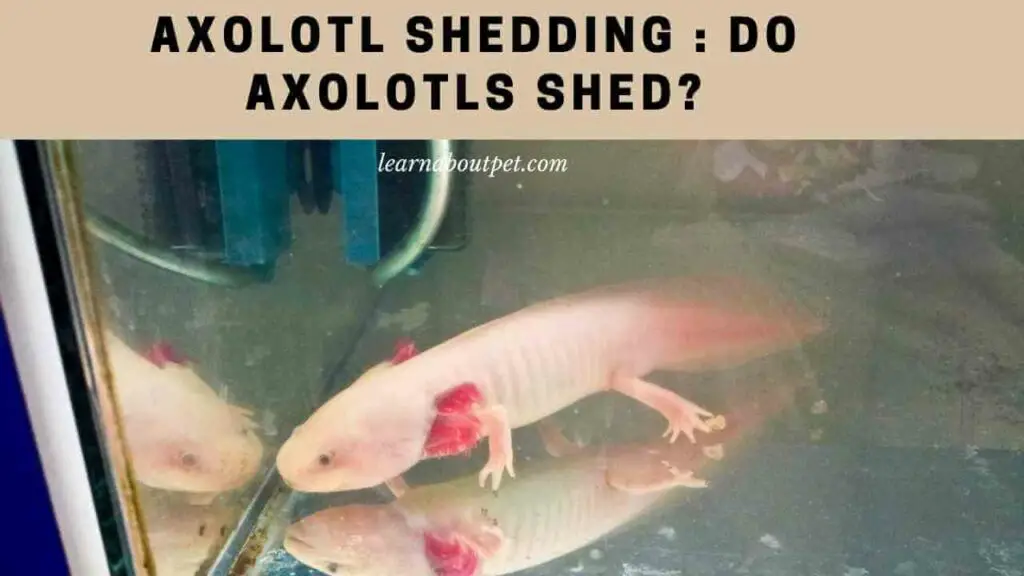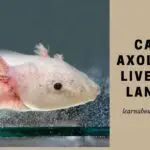Having an axolotl can be confusing if you are first taking care of it. One of the conditions that make owners panic is axolotl shedding their skin or gills. If you don’t know the cause, you will be worried whether the axolotl is sick.
Do Axolotls shed? Axolotls do not shed naturally. The axolotl can be shedding if something happens with water parameters or the axolotl is under stress. If the water is in bad condition, the axolotl’s skin might get damaged and shed their slime coat.
To ensure conditions during axolotl shedding, how to prevent it, or give the correct treatment, you need to read this article to the end.

Do Axolotls Shed Their Skin?
Before axolotls shed their skin, there was still a slime coat to protect against the skin with slippery substance and was on top of the skin. The slime coat protects axolotl skin from harmful particles, fungus, or bacteria.
Slime coat shedding is an early sign of deteriorating water conditions in the tank. Always check the water level to ensure your axolotl is in good health condition.
If the slime coat is left untreated and the axolotl shedding its skin, it might cause severe diseases that can lead to death. Always check the water parameters before bad things happen to your axolotl.
Is Axolotl Shedding Bad?
Axolotls can shed their slime coat if the water starts to get dirty and some water parameters don’t meet the requirements. Axolotls can be stressed, and their body condition will deteriorate due to dirty water.
Axolotl shedding is not something to worry about because axolotl can regenerate. But that does not mean the condition can be left alone for a long time. If water conditions continue to deteriorate, the regeneration process may lose out to the shedding process.
Do a water change once a week, even if you use a water filter on the axolotl tank. When you do the 20-30% water change, the oxygen circulation in the water will be more, and the axolotl can get the correct water requirements.
Any shedding that occurs in the axolotl is awful. Axolotls in usual condition will not shed their slime coat, skin, or gills.
Can Axolotls Regrow Their Slime Coat?
If the water conditions improve, the axolotl can start regenerating its slime coat. A healthy diet can also help axolotls in accelerating their regeneration process. If the condition of the water is still dirty, the regeneration process will be disrupted.
Every time axolotl shedding occurs, the axolotl can restore its slime coat to its original condition. The slime coat regeneration process is faster than axolotl’s skin regeneration.
Not only slime coats, but axolotls can also regenerate body parts such as gills, legs, or internal organs. Scientists are still researching the axolotl’s regeneration ability because the axolotl is the animal with the fastest regeneration ability.
Do Axolotls Shed Their Gills?
Curled gills are the primary sign of an axolotl being in a tank with awful water conditions and experiencing stress. If the ammonia level in the tank continues to rise, and you leave it for a long time, the axolotls can get ammonia burn and the axolotl shedding their gills.
If you know gills are the organs for them to breathe, then you must solve the problem of gills before the axolotl’s condition gets worse. Clean the water in the tank by cleaning uneaten food, axolotl waste, or dead plants.
Do a water change to increase the oxygen supply in the axolotl tank. After the tank cleaning process is complete, see the condition of the axolotl in the next few hours. If their conditions are better, then the main problem with shedding gills is dirty water.
Do Axolotls Have Slimy Skin?
Axolotl has a slimy substance to protect its skin from bacteria, fungus, or harmful particles. The slimy skin keeps its body moist and regulates its temperature. When axolotl shedding due to poor water conditions, the first thing to shed is the slimy coat before the axolotl skin.
If the slimy skin is damaged, it will look like a white sheen and become a reference if the water in the axolotl tank needs to be cleaned. Do not leave the axolotl in dirty water for a long time so that the axolotl is not stressed and susceptible to any diseases.
Why Is My Axolotl Slimy?
Most animals that live in water will be slimy because the texture of their skin is mixed with water. You can check the slimy body of an axolotl by taking it out of the water for a moment. Don’t leave axolotls out in the water for too long because they are not salamanders that can live on land.
Axolotls can only last a short time in the land until their bodies are dry before they run out of breath. Although axolotls have lungs, they cannot use their lungs to breathe normally like other adult salamanders.
Axolotl also has a slimy coat that serves to protect their skin from any harmful particles. If you want to move the axolotl temporarily, prepare another tank with dechlorinated water and put the axolotl there while you clean the axolotl tank.
Do not leave the axolotl outside the tank. Axolotls can only survive out of the water until their bodies dry up.
Why Is My Axolotl Tank Slimy?
Young axolotls will secrete white mucus more often than adults. If the white mucus makes the axolotl tank slimy, lift the axolotl and place the axolotl elsewhere while you clean the tank.
Algae can also cause slime in the places where they grow. If the axolotl tank has algae, it is a sign the water is not clean. If you have more than one young axolotl in the same tank, more slime is produced, and you need more time to clean the tank.
Clean the water and replace the water with dechlorinated water until the slime is gone. If axolotl still produces a lot of slimes you need to clean the water in the tank more often so that the water parameters meet the requirements.
Clean the tank glass from the slime. The slime can be mixed again with the water, if the slime stuck to the glass is not cleaned or when you fill it with new water.

How Do I Keep Slime Out Of My Axolotl Tank?
Axolotl tanks can be slimy because there is algae in the tank. If the algae are not cleaned, the axolotl can be stressed because the ammonia level rises.
Clean the axolotl tank once a week, get rid of the algae, and some things that can increase ammonia, such as dead plants, uneaten food, or axolotl stool.
If you don’t have a water filter, you will need to change the water more often. Axolotls are animals that produce a lot of waste. If the waste is left unchecked, an ammonia spike will occur, and it can poison the axolotl.
Algae can appear because you overfeed the axolotl. Uneaten food can turn into algae, and algae can make a tank feel slimy. Scrub the glass inside of the tank and change the water almost completely. If the slime problems don’t go away, move your axolotl to another tank.
If axolotl shedding occurs, check every corner of the axolotl tank for algae or uneaten food that you missed the last time you cleaned the tank. Slimy tanks make the water condition worse. The clear color of the slime will make it difficult for you to see it from afar.
Axolotl Skin Peeling Off – What Should I Do?
Several factors cause axolotl skin to peel off. If you put the axolotl in a new tank, and the new water still contains chlorine or chloramines, the axolotl’s health can be compromised and peel off their skin.
You can do treatment with a tea bath or put almond leaves into the tank. See the condition of the axolotl in the next few hours, whether his body condition improves. Do not use the salt bath method, because it will hurt your axolotl.
Axolotl shedding is a problem that often arises because ammonia or nitrite levels are above normal. Axolotls become stressed, and peel their skin off because they detect water requirements that do not match their needs.
Axolotl skin will not suddenly shed if you can maintain water conditions, temperature, and cleanliness. Remember, only use dechlorinated water to replace the water in the axolotl tank. Water that is not suitable for axolotls will stress axolotls and worsen their body condition.
Fridged Axolotl Suddenly Peeling – Why?
If you are fridging the axolotl because you see the condition of axolotls peeling their skin, you are doing the right thing. If we don’t know what happened to the axolotl, one of the treatments that can help the axolotl is fridging or a tea bath.
If the problem is not a fungus, do an ammonia and nitrite check in the tank. If the ammonia level is at 1.0 ppm, then you need to do a 20-30% water change, don’t put the axolotl back in until the ammonia and nitrite levels are at 0 ppm.
Axolotl shedding because of something off in the tank. If the ammonia level is more than 0.1 ppm, the axolotl begins to perform strange behaviors such as lethargy, floating, and shedding slimy coats.
Do fridging if necessary, but do not immediately put the axolotl back into the tank until you ensure the water conditions in the tank are in a safe condition.
Some axolotl owners have to see their axolotl passed away because they are in a hurry to put the axolotl back into the tank without re-checking the water parameters.
Can Axolotl Regenerate Their Gills?
Axolotl gills can fall off due to unfavorable water conditions. If you can restore the condition of the axolotl water, the axolotl health will return to prime and the regeneration process can begin.
Axolotls can regenerate their gills, skin, and internal organs. Although it takes a long time, the axolotl’s regeneration process is the best compared to other salamanders.
Axolotls shedding their gills due to rising ammonia levels, and axolotls must endure these conditions until they are moved elsewhere. If you don’t do regular water checks, the axolotl will suffer the consequences.
Common Reasons Why Is Your Axolotl Shedding
No axolotl owner wants their axolotl to be in bad shape. Keeping axolotls healthy will ensure they live up to their life expectancy as long-lived aquatic pets. The table below lists the common reasons why is your axolotl shedding.
| Axolotl Shedding factors | Explanation |
| Chlorine | Axolotl tanks use tap water which still contains a lot of chlorine and chloramines. These chemicals can burn the axolotl’s skin and cause shedding. |
| Tank mates | Axolotls can be stressed because they are overcrowded or there are fish that are aggressive towards axolotls. If an axolotl is injured, their skin may shed. |
| Ammonia level | Ammonia levels above 0.1 ppm are harmful to axolotls. If left unchecked, not only shedding their skin, axolotls can also shed their gills. |
| Fungus | The white color on the axolotl skin is a fungus that can grow and damage the axolotl skin. |
| Dried out | The axolotl has been out of water for too long, and the water in the axolotl’s body has dried up. The slimy coat will shed quickly before the axolotl has difficulty breathing because it has dried out. |
Final Verdict – Axolotl Shedding
Many factors cause axolotl shedding. The most common cause is water parameters. If the axolotls are in a tank with high ammonia or nitrite levels, a lot of waste that isn’t cleaned up, and a lot of algae in the tank, the axolotls could shed their skin.

You need to do regular water checks and change 20-30% water to keep the tank clean and keep the ammonia level steady at 0 ppm. A sign that the axolotl tank needs cleaning is that the axolotl will shed their slimy coat. If it is continued untreated, axolotls can shed their skin or gills.
Stress can also cause axolotl skin to shed. Meet the water parameters, so the axolotl can live healthily and live according to life expectancy.

Welcome to Learn About Pet. My name is Rajkumar Ravichandran and I love all pets, travel, and amazing food. I write about my passion and personal experience caring for multiple pets in this blog! ❤️
Post Disclaimer
DISCLAIMER: THIS BLOG OR WEBSITE, "Learn About Pet", DOES NOT PROVIDE YOU WITH MEDICAL ADVICE AND IS NOT A SUBSTITUTE FOR MEDICAL ADVICE. ALWAYS GET IN TOUCH WITH YOUR PERSONAL VETERINARIAN AND USE INFORMATION HERE AS GENERAL ADVICE.
The information, including but not limited to, text, graphics, images and other material contained on this website are for informational purposes only. No material on this site is intended to be a substitute for professional veterinary advice, food recommendation, diagnosis, or treatment. Always seek the advice of your veterinarian or other qualified health care provider with any questions you may have regarding a medical condition or for pet food related questions.







